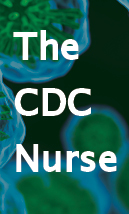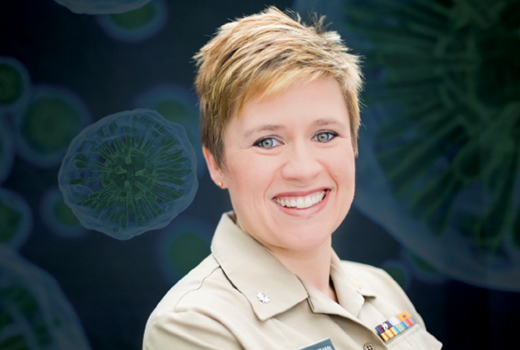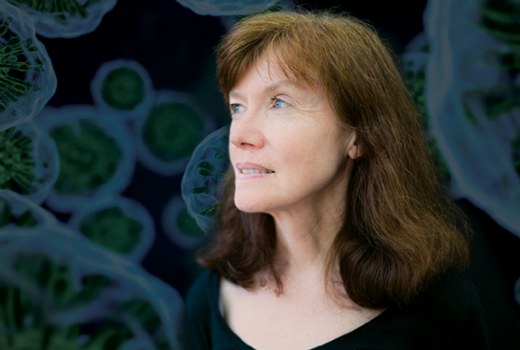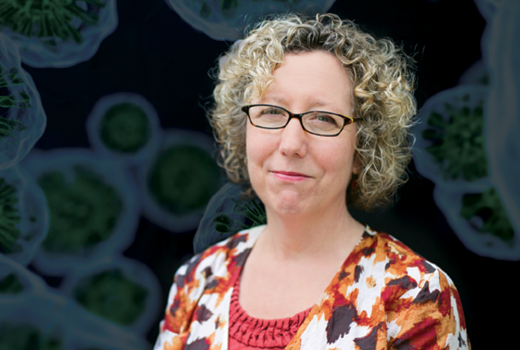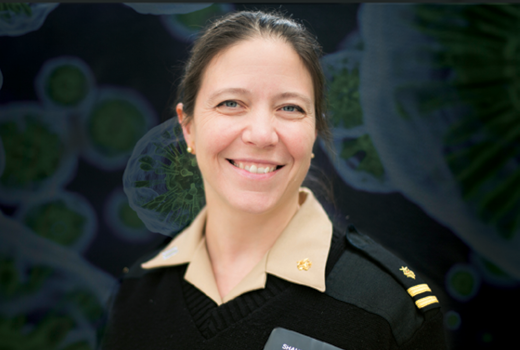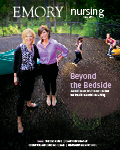The CDC Nurse
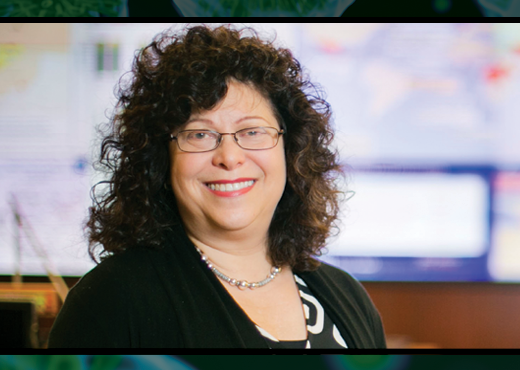
While Emory nursing alumni who work at the Centers for Disease Control and Prevention share the credential "RN," they hold various positions with titles other than "nurse"—program manager, epidemiologist, public health adviser, statistician, behavioral scientist, contractor, and deputy director. Currently, 25 alumni serve with the CDC. Whatever their job description, all share a commitment to improving the health of people and communities.
By Pam Auchmutey
|
|
Bracing for Influenza
When someone asks Lisa Koonin 86MN 86MPH what she does for a living, she has a ready response.
"I plan and prepare," says Koonin, senior adviser for the Influenza Coordination Unit at the CDC. "I think through things that people don't have on their radar screens. If there's an outbreak of influenza, it could present a lot of thorny problems."
This past spring, Koonin spent long hours in the CDC's Emergency Operations Center to help monitor the outbreak of avian influenza in China. Whether it's H7N9 or the H1N1 flu, which spread rapidly from Mexico to the United States in 2009, Koonin leads the task force that considers and plans for providing medicines to ill persons and guidelines to health care providers if a pandemic occurs.
During the 2009 H1N1 pandemic, Koonin led an initiative to deliver flu vaccines to pharmacies to get them to the public more quickly. Within days, her unit put together a plan to distribute 5.4 million doses around the country with the help of large pharmacy retailers like CVS and Walgreens and pharmacies in grocery and big box stores.
In 2009, the Minnesota health department developed a nurse triage line to advise callers on how to treat H1N1. The health department also used a protocol whereby nurses provide patients with antiviral medicines under physician supervision. Currently, Koonin is leading a CDC effort to test this concept for nationwide use during a future pandemic. This effort aims to reduce treatment delays by speeding up the availability of medicine and reducing surge demand on medical facilities.
"Most people with a health insurance plan are likely to have access to a nurse triage line. We would like to create a triage line for those who don't have access," says Koonin. "The CDC project is trying to leverage the existing resources of entities that do this work every day. There are 57 poison control centers in the United States staffed by nurses and pharmacists. We're looking at these services as a way to expand the triage network."
The project, still under development, "capitalizes on the unique talents of nurses to teach, coach, and provide timely information to help people make health decisions during a public health emergency," she adds.
Since joining the CDC in 1987, Koonin has served as chief of reproductive health surveillance, director of the Office of Healthcare Partnerships, and branch chief for Public and Private Partnerships. She first worked as a nurse with a family practice in rural North Carolina. In May, she received her doctorate of public health from the University of North Carolina at Chapel Hill.
"I never thought in a million years that I would end up with a career in public health," says Koonin. "It's been a wonderful career to have."
At the Heart of Public Awareness
Each year in the United States, 600,000 men and women die of heart disease. Despite all that is known about prevention and risks, heart disease causes one in four deaths annually.
"The public doesn't realize that heart disease is the leading cause of death," says Amy Valderrama 01MN 06PhD of her motivation as an epidemiologist with the Division for Heart Disease and Stroke Prevention at the CDC.
Valderrama relies daily on her skills and training as a nurse clinician and researcher to guide the collection and analysis of data to answer questions that arise in working with state health departments and various divisions at the CDC.
"In my division, very few people have a clinical background," she says. "When questions come up that require a clinical opinion on heart disease or stroke, they are sent to one of us."
Among her accomplishments, Valderrama led the development of the CDC's Vital Signs program in September 2012 on uncontrolled hypertension, which included an article in the Morbidity and Mortality Weekly Report. In conjunction with publication of the article, the CDC hosted a virtual town hall to answer questions from state and local health officials and a teleconference for health bloggers who could then post information about hypertension on the web, Twitter, and Facebook. She also has collaborated with the CDC's Division of Reproductive Health on several journal articles about hypertension screening and treatment among women of childbearing age.
Valderrama has treated heart and stroke patients in open heart ICUs in West Virginia and Georgia. As a doctoral student at Emory, she studied the predictors of fatigue in patients with permanent atrial fibrillation. At the CDC, she is now on temporary assignment with the Center for Global Health to provide expertise on hypertension.
"The CDC has been a great experience," Valderrama says. "You're working with a variety of colleagues and learning at the same time."
From Local to Global Health
Tuberculosis is Kay Lawton's favorite disease. She developed her affinity while working as a public health nurse with the DeKalb County Health Department. She regularly treated TB patients at home and came to know them and their families.
"A lot of them were very cool characters," says Lawton 78N 84MN, who rose through the ranks of the health department to become director of nursing. But that was as far as she could go. In 1988, she joined the CDC's Division of TB Elimination as a nurse consultant.
"I worked with nurses all around the country who were managing tuberculosis care and prevention programs in state health departments," she says.
Intent on moving into the management track, Lawton joined the Division of HIV/AIDS Prevention in the early days of the AIDS epidemic. She remained with the division for 10 years and ultimately became deputy chief of the Prevention Services Research Branch. During the next decade, Lawton served as deputy director of the Division of Parasitic Diseases, part of the National Center for Infectious Diseases. She logged thousands of miles worldwide and traveled primarily to field stations in Guatemala and Kenya, both rich environments for testing malaria interventions.
In 2011, Lawton joined the Center for Global Health to oversee its management, operations, and infrastructure. Of the 1,500 people who staff the center, 350 live and work in other countries. "It's a very dynamic environment," says Lawton of the center. "There's always an evolving, urgent situation that requires us to quickly deploy lots of people to build the infrastructure to support a particular investigation or endeavor.
"We're always looking to bring young professionals into the field of global health," continues Lawton, a participant in the School of Nursing's speed mentoring program for students. "You need that constant infusion, which drives the care and feeding of our student and fellowship programs to make sure we are always bringing in new blood."
Talking up sexual health
CDC health scientist Rheta Barnes 99MN/MPH thinks and talks about sexual health every day. Discussing it is paramount in her work to prevent sexually transmitted diseases (STDs).
"Sex affects just about everybody," says Barnes, who leads a training unit in the CDC's Division of STD Prevention (DSTDP). "It's an important part of people's health care, but it's often overlooked because providers and patients may be uncomfortable talking about it. Some of the training we provide is designed to make providers more comfortable. By talking about sexual health, you can have a positive effect on someone's life by preventing or promptly treating an STD."
Barnes saw the effects of STDs while practicing at Hughes Spalding Pediatric Hospital and as a visiting nurse in Atlanta. After completing her dual degree at Emory, she accepted a fellowship at the CDC focused on STD control to prevent HIV. The fellowship led to her position in the DSTDP, where she now manages two training programs for health professionals.
One program targets disease intervention specialists at state and local health departments. The other program provides funding for STD/HIV Prevention Training Centers. Through this network of regional centers, specialists train clinicians nationwide who serve populations at risk for STDs and HIV.
"These centers train about 4,000 clinicians per year face-to-face," says Barnes. "About 40% of them are nurses. Of those, about 15% to 20% are nurse practitioners. That's in addition to clinicians who receive online training."
Barnes' unit took the training modules for STDs and translated them into web-based self-study curricula for clinicians. Trainers are now updating the curricula to include the latest STD treatment guidelines. Her unit also developed a ready-to-use curriculum for nursing and medical faculty.
For many nurses, direct contact with patients drives them in their work. The nurses in Barnes' division are far removed from that. "We provide training to clinicians so they can provide optimal care to their patients," she says. "That's where we can focus to make a difference."
Band of Nurses
During National Nurses Week in May, more than 250 Georgia nurses gathered at the CDC to brainstorm on ways to bridge public health and health care. Shauna Mettee 09MN/MPH, president-elect of the CDC/ATSDR (Agency for Toxic Substances Disease Registry) Nurses Work Group, led the development and coordination of the daylong symposium.
"As trained ‘system thinkers,' nurses are uniquely poised to address prevention and quality of care," says Mettee. "Nurses can bridge the cultural gap between public health and clinical care and be innovative leaders in this time of health system change."
The CDC/ATSDR Nurses Work Group includes nearly 200 nurses across the globe who support the CDC's mission of protecting health and saving lives.
"While ‘nurse' is rarely in our official title, nursing expertise and training strengthen our impact at the agency and in the communites we serve," says Mettee.
A former laboratory scientist, emergency room nurse, Epidemic Intelligence Service officer, and CDC fellow, Mettee is now a public health adviser in the CDC's Office of the National Prevention Strategy (NPS). Mettee provides technical assistance to the National Prevention Council, led by U.S. Surgeon General Regina Benjamin, which developed the NPS to increase the number of Americans who are healthy at every stage of life.
The CDC/ATSDR Nurses Work Group is looking to expose more Emory nursing students to learning and career opportunities at the CDC. Mettee hopes to replicate the success of the Student Outbreak Response Team (SORT), a volunteer group at Rollins School of Public Health that assists with local outbreak investigations and emergency preparedness. As a student leader with SORT, Mettee helped strengthen its ties with the CDC.
"Nursing students are often unaware of the exciting array of opportunities available to them beyond the clinical realm," says Mettee. "Working at the CDC, I've had the chance to use my nursing training and clinical experience to try to improve health at the population level. It's a wonderful place to work."


